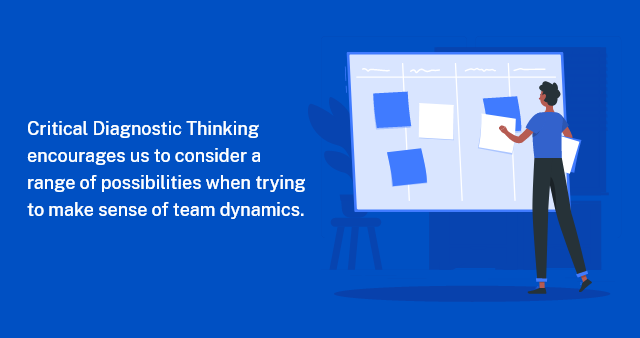Improving Project Management Through Critical Diagnostic Thinking
11.10.2021Collaboration is more than just working together. To be successful, it requires understanding the larger context in which we work and interact with our teammates in addition to realizing how our own individual experiences shape our behavior continually.
As part of our ongoing efforts to foster deeper conversations about the “how” and “why” of our work, the DOOR3 symposium series hosts experts from relevant areas outside of software development and technology consulting to share new perspectives from their research and practice. After our previous symposium, which focused on team dynamics, we were looking for a hands-on session to further our exploration of team cohesion. Fortunately for us, we had the pleasure of hosting organizational psychologist Dr. David Berg who specializes in the dynamics of groups and organizations. He organized an immersive experience for attendees to practice and discuss how thinking about everyday interactions in different ways can improve cohesion within teams and across the entire organization.

David opened the discussion by introducing one of the main difficulties in understanding behavior within and between groups: our own struggle to think about interactions with others in a truly objective manner. It can be nearly impossible to parse not just how our own subjective experiences and roles influence how we relate to others, but also in turn how their backgrounds and expectations play a role, not to mention the impact of larger organizational structures. While friction between individuals and groups can impede work, power dynamics and hierarchies can also impact employee interactions and how decisions are made.
To delve further into this, we were given a case study to read and analyze. It described a meeting in which a newly appointed department head reviews updates to governmental regulations. A senior member of the team makes snarky remarks throughout the presentation and their colleagues capitulate by laughing. We were prompted to analyze what went on in the meeting—and what we could do about it.
While there is no right answer, the exercise illustrates three salient points. First, we usually look to individuals to explain cause and effect within social interactions. This means that a disruptive person might be scapegoated for an unsuccessful meeting, instead of examining the behavior of the individual in context, perhaps as indicative of larger organizational issues. Second, while individual behavior is important, perhaps as a starting point for analysis, the interpersonal, group, and intergroup perspectives provide a more holistic framework for understanding communication among teammates. How did others in the meeting feel? What compelled them to laugh along? Last, the complexity of holistic perspectives requires us to engage in thinking that may challenge our assumptions and necessitates a deeper exploration of the context in which people work. This must include the impact of their social identities and how they reflect broader social constructs such as power dynamics and hierarchies.
Learning to apply diagnostic thinking at DOOR3

While this kind of critical thinking is essential, it’s also challenging, given our own personal blind spots and the narratives we tell ourselves about our place in the world. As David assured us at the beginning of the workshop, while the exercise might not change our behavior in any way, it did help us understand more about our motivations and actions as both individuals and members of larger social groups. Rather than expecting to circumvent our own character, critical diagnostic thinking encourages us to consider a range of possibilities when trying to make sense of team dynamics.
This holistic approach is a challenging prospect, especially because it calls on leadership to use their authority to analyze shared issues and implement solutions. Interactions between individuals carry the weight of their identities, context, and histories and often we don’t even know all that might influence this. In David’s example, once we considered the outspoken individual’s behavior as representative of a role they are playing within the larger intergroup context, we saw that we were missing a lot of information about the people in the snapshot, without which we couldn’t make a balanced decision.
The well-attended workshop opened our eyes to the work required for the type of critical diagnostic thinking that helps groups succeed over time. The larger-scale perspectives David spoke about are valuable beyond the situational because they empower us to cultivate sustainable relationships across the entire organization that can adapt and change.
As DOOR3 grows, our challenge is to maintain and evolve our ability to collaborate. In an industry and economy that champions rapid growth and an entrepreneurial ideology that encourages people to “move fast and break things,” it is difficult to take a step back and ask poignant, holistic questions about how we work and why. However, successful collaboration depends on a solid foundation, which we can build on our understanding of organizational structure and how we operate within it. In future posts, we will look at further ways understanding social relationships helps us work smarter. Stay tuned.
Dr. David Berg joined us from the Yale School of Medicine where he is now a clinical professor of psychiatry, as well as a member of the core faculty of the Robert Wood Johnson Clinical Scholars Program where he helps medical students, residents, chief residents, and fellows deepen their understanding of groups and organizations. Additionally, he also brings over 30 years of experience as a consultant, working with large and small private corporations, nonprofit organizations, and public sector agencies to bridge the worlds of ideas and practice.
As we delved into the importance of critical diagnostic thinking for project management, it’s worth noting that business analysis plays a significant role in aligning project goals with organizational objectives. This holistic approach encompasses various aspects of project success, including effective resource allocation and stakeholder engagement. Contact us today for any queries.



